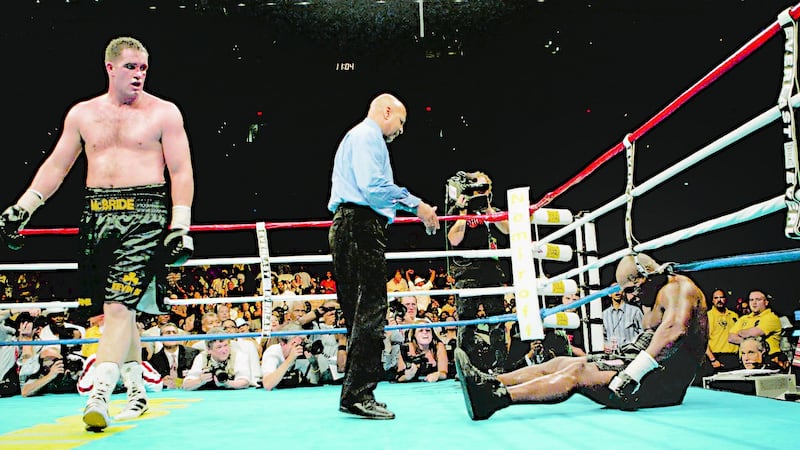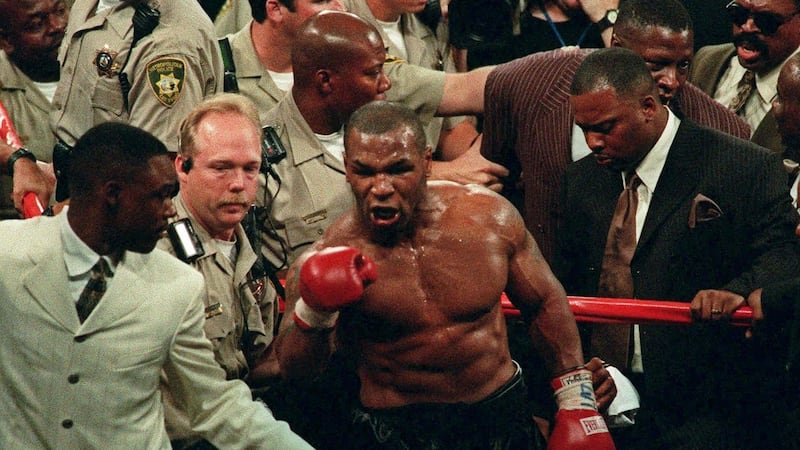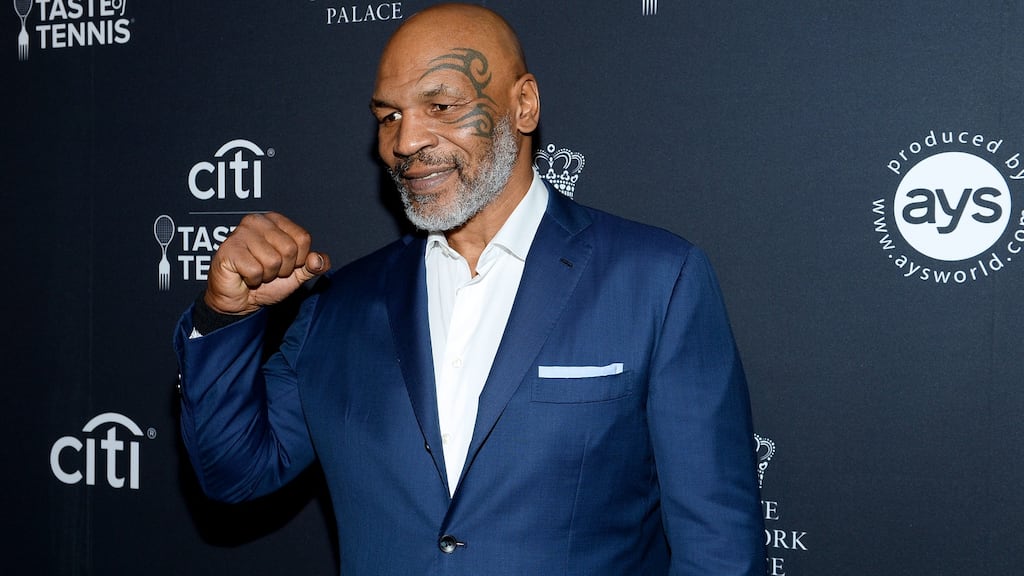It drives F Scott Fitzgerald scholars and fans batty that arguably his most quoted line is also his most misquoted. It has, of course, never been true that there are no second acts in American life. The current occupant of the White House is the most audacious and frightening truth of that.
And now Trump's old friend Mike Tyson has announced that he will be dusting down the iconic black shorts and boots combination for a boxing match against Roy Jones junior. The youngest ever heavyweight champion of the world is now 54 years old. Jones is 52.
The announcement is no real surprise. Mike Tyson has been posting footage of high octane and sleek workouts – against a trainer holding pads– for his 12 million followers on Instagram. Even so, there is something electrifying about that crouched stance and the almond eyes glittering. And with 2020 stuck on pause because of the pandemic, it has been the year of nostalgia.
So it is the perfect timing for Iron Mike to return to the ring and the bout, an eight round exhibition scheduled for Las Vegas in September, gives plenty of scope for a comprehensive rehashing of the Tyson story for the billions who weren’t even on the planet in the 1980s and 1990s when he was comfortably the most notorious sports figure alive.
It will be a cash cow. And the boxing fight is just one of several pots that Iron Mike has on his stove. Since California legalised marijuana, Tyson has moved into the business that may just be the millennial equivalent of the gold rush. He is building the Tyson Ranch, a vast weed/theme park which, among other things promises the longest lazy river in the world on which you can float down while stoned off your face – not an attraction you will find in the Center Parcs brochure.
Motley
When he isn’t training these days, Tyson can be found holding court on his Hotboxin’ podcast, on which the crew of guests is indeed motley. Stars who have dropped by include Michael Rappaport (Phoebe’s cop boyfriend in Friends), Snoop, Piers Morgan and Denis Rodman. But the entire show revolves around the very first episode, when Mike and his co-host talk about life with a buck by the name of Dr Gerry.
This is not the kind of Dr Gerry might find in your local clinic – or at least, if you do, then best read the prescription he writes you twice. Gerry tells Mike about this truly life-altering medicine he has discovered, extracted from the venom of a rare species of toad found only along the Mexican-US border.
Gerry told him that smoking the toad was like “freebase jumping into the heart of God and coming back– in just 20 minutes”. This was a jump Mike wanted to make – and duly did, cutting the podcast (which is filmed) and then returning a half hour later with a dopey smile on his face and brand new insights into the whole existence-of-the-world and why-are-we-here vibe.
It turns out that smoking the toad is comparable to gaining “30,000 years of experience in around 20 minutes” –which is convenient if you are on a tight schedule. Mike regularly invites his guests to smoke the toad and it’s a matter of universal regret that Piers Morgan was not game.
Tyson’s behaviour after his rapid ascension to the pinnacle of the last great heavyweight era, was to conform to the role of monster that many believed him to be. His public life revolved around his conviction for the 1992 rape of a beauty queen contestant, a verdict he has never accepted. He served his sentence and returned to boxing as a figure of curiosity: a moving freak show, blowing millions, addicted to everything, mowing down opponents, making increasingly wild and nihilistic pronouncements and sometimes sounding sorry for himself. He remained wildly popular, too, standing a symbol for someone who couldn’t quite be tamed, who lived to his own rules and who created his own moral universe.
I was in Tyson’s immediate vicinity twice. Once was in London in 2000 when he was preparing to fight Julius Francis. By “preparing” I mean watching from his Park Lane hotel as throngs of fans gathered outside and by causing mayhem for the metropolitan police when he left for periodic shopping raids to buy luxury cars and diamonds or whatever shiny thing caught his eye. It felt as though Tyson was bigger than London just then.
Last ever fight
The next time was five years later for what turned out to be in his last ever fight, against the Irish boxer Kevin McBride. It was in Washington DC. They held the weigh in at Howard University. “I’m gonna gut you like a fish,” Tyson promised the big Irishman.

They held a pre-fight party on the Sequoia, JFK’s old yacht. The fight was attended by a few flash-in-the-the-pan celebrities and also by one of the defining figures of the American 20th century: Muhammad Ali. He was there to see his daughter Laila fight on the undercard.
And there was something very forced and depressing about the entire event. Tyson’s pre-match menace felt contrived and sounded tired. You could tell that nobody’s heart was really in it. It was just entertainment: a pay day.
Tyson was by now a ghost of the ferocious, combustible wrecking machine who, as a teenager, had made older, mean men tremble with fear. He was done. The punches were still quick but lacked weight and sting. The footwork was still dazzling but the body movement sluggish. He was ineffective and his boxing career ended when the bell rang for the sixth round and Tyson just remained seated on the stool, declining to fight on. He was literally finished.
That was 15 years ago and it was hard, that night, to imagine where Tyson would “go” after this now that his commodity as a fighter had been truly spent. The roadway is littered with the burnt-up shells of once big name stars.
But when you review all of Tyson’s public life, from the grainy footage of the future sensations training the Catskills with Cus D’Amato through to his rambling, theatrical one-man shows, Tyson had an uncannily brilliant instinct for self-mythology.
In the loudening argument for federal reparations to be made to the African-American lives, look at Tyson’s life prospects, born in 1966 in the bleakest part of Brownsville and raised, as he puts it, among “pimps and prostitutes”. The projected arc of the pre-ordained life suggested addiction, imprisonment, early death like many of his peers. Boxing and luck was his escape clause.
Unrestrained aura
His path is an extraordinary story and nobody enjoys hearing it more than Tyson himself. The dude will never quite get over himself. Establishment America hasn’t turned its back on him for the rape conviction: he has had the sit down with Oprah, he has appeared in mainstream Hollywood hits like The Hangover. He was the star of a Spike Lee documentary. And he has retained the edgy and unrestrained aura of wildness which has become his second commodity and which, unlike boxing, has no age limit.

On his podcast, you can watch Mike smoke his blunts and engage in that most millennial of pastimes, “sharing” his feelings. “I was petrified,” he tells a sceptical Piers Morgan of his emotions in the ring.
Mike Tyson is a more savvy and controlled media operator than the sometimes vulnerable and sometimes thuggish fight champion who appeared on news and sports clips years ago. The 20-year-old Mike Tyson, all glint and menace, would have had something sharp and savage to say about the sight of the 50-something greybeard Tyson climbing back into the ring. But that’s okay.
Because Mike Tyson has managed to parlay that old notoriety into his own second act, where he continues to learn and to fail and in a world where he is, against the odds, still thriving and where he is always ready to forgive himself.













